Rainwater harvesting is an environmentally friendly practice and a great way to cut down on the cost of utility bills. Collected rainwater is suitable for use across the garden and is great to have on hand for emergencies.
With the proper treatment, the water is even suitable for drinking. Rainwater harvesting is an incredibly worthwhile practice. However, there are many factors to consider before purchasing a tank.
You will need to consider what size suits your needs, whether a modern poly plastic tank is best or a classic steel tank, and how you plan on using the water.
This comprehensive guide covers everything you need to know about purchasing rainwater tanks in Australia and getting the best possible results out of harvesting rainwater.
More...
Benefits of Rainwater Harvesting

When a house is connected to a rainwater tank, the entirety of runoff from the roof and gutters can be captured and stored for further use. A study by the ACT Government shows that if you live in a typical townhouse and you divert just one of your downpipes to a water tank you can save about 25kL a year with a 500 litre tank (where 1,000L = 1kL).
Rainwater is a natural resource and is free to everyone (unlike water supplied by the council), and the stored tank water can be used for almost anything. Suitable uses include:
- Watering plants
- Flushing toilets
- Washing dishes and clothes
- Showering and bathing
- Firefighting
- Drinking
Yes, stored tank water can be used for drinking. However, it may need to be treated with appropriate chemicals before it's safe to do so.
Simply connect a suitable hose to the tank to use the water across the lawn and property. Then, talk to the team at Book a Plumber Online to install a pump and connect the tank to household faucets for the water to be used across the kitchen, bathroom and laundry.
According to the Department of Health, rainwater tanks are already the primary water source for 10.1 per cent of Australian households.
With an impressive rate of 22%, South Australian households are twice as likely to use a rainwater tank as their primary water source compared to the national average.
Long Term Savings On Your Water Bills

The Australian Bureau of Statistics reports that the average Australian household uses just under 180kL litres a year, that equates to roughly 493 Litres per day.
Water itself is low cost, priced between $1 and $5 per 1 kL, depending on the rates set by the local water authorities. In Melbourne, for example, prices start at $2.63 per kL.
If you use a rainwater tank for just half of all household water usage, you could save around $89 on water bills each year. That number will only rise for larger than average families and when using water in Western Australia and Queensland, who generally charge more than the other states.
The savings alone may not persuade you to install a rainwater tank. But when combined, all of the benefits can make rainwater harvesting an incredibly worthwhile endeavour.


Get Your Free Guide:
Master Growing Australian Natives eBook
A Must Have Complete Guide for Every Australian Garden
Get Your Free Guide:
Master Growing Australian Natives eBook
A Must Have Complete Guide for Every Australian Garden
Water Storage for Emergencies
Having a rainwater tank ready to go in case of emergencies can help protect the home and family from natural disasters. For example, areas prone to bushfire rely on rainwater tanks to provide firefighters with the means to combat the blaze once their engine tanks have run dry.
On the other hand, heavy rain can cause flash flooding. A neighbourhood of tank owners will reduce the water flowing into yards and stormwater drains, minimising the impact of the flooding.
Many councils across Australia are making rainwater tanks mandatory for new homes to help combat natural disasters.
Easing Water Restrictions
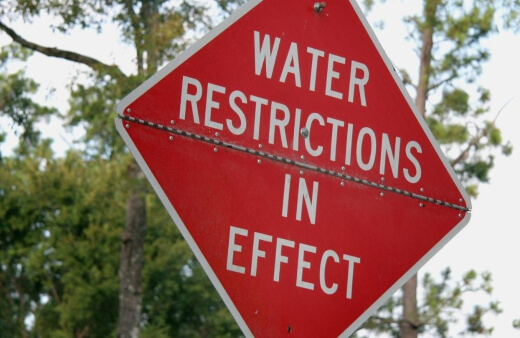
Drought conditions can see government agencies impose water restrictions, limiting your daily water usage. When access to running water is reduced, watering plants, washing the car and filling the pool must often be dismissed.
A rainwater tank can provide you with plenty of water to use across these chores without affecting reservoir levels and facing the wrath of the local council.
Types of Water Tanks in Australia
There's a massive selection of tanks available to meet your rainwater harvesting needs. The perfect option depends on the following criteria:
- Purchase cost
- Storage capacity
- Shape
- Material
- Colour
- Positioning
From small, portable poly water tanks you can move around the yard to permanent concrete solutions for commercial purposes, these are some of the most common options available today:
Round Rainwater Tanks

The iconic round, galvanised steel tank is a time tested water storage solution. It remains popular with people living in rural areas where it matches the aesthetic of farmhouses, and the tanks need to be resistant to weather extremes.
Steel rainwater tanks offer considerably higher durability than poly tanks, without the hefty price tag or limited mobility of concrete tanks. Galvanised stainless steel tanks offer better longevity than other materials and improved resistance, but they do cost more upfront.
Plastic or Poly Rainwater Tanks

Plastic tanks (or poly tanks), are popular because of their high quality and affordability. Constructed from polyethylene, poly water tanks can meet the aesthetic requirements of modern homes and are available in various shapes and sizes to suit all homes.
Cement or Concrete Water Tanks
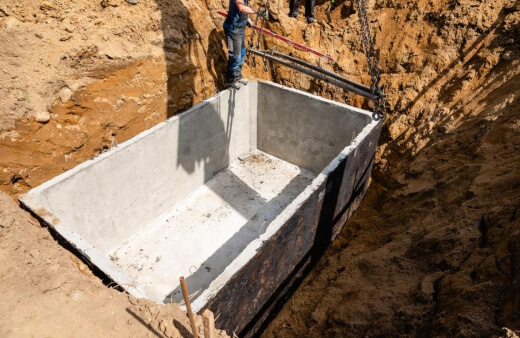
Concrete rainwater tanks are typically the sturdiest and most expensive rainwater tanks on the market, so it's no surprise they are mainly used for commercial water storage.
Concrete water tanks are thick, durable, and have the longest lifespan of any water storage - they may last for up to 50 years with appropriate care. However, there is potential for minerals (including lime) to leech out of the concrete into the water reducing its quality.
Fibreglass Water Tanks
Fibreglass rainwater tanks are among the cheapest options available. They are lightweight, easy to install, and have a long lifespan with regular maintenance.
The lightweight, rigid construction keeps the prices down but also means they are more brittle and can crack when exposed to years worth of harsh Australian conditions.
Rain barrels
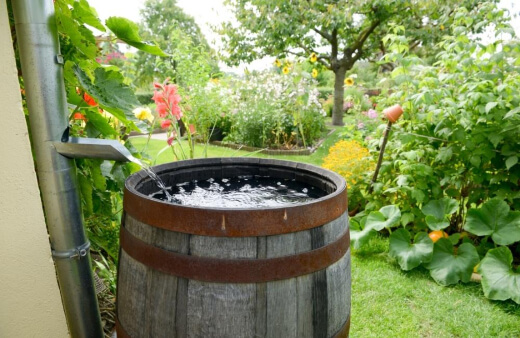
The most basic form of water storage, rain barrels, are small rainwater tanks with the size and shape of a traditional barrel. They are perfect for storing and moving water around in a backyard and are often available as poly tanks or steel tanks.
Slimline Water Tanks
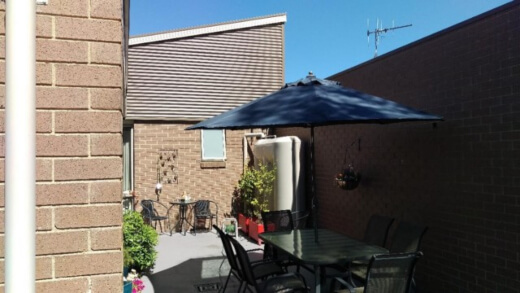
The slimline water tank is the original space saving solution for water storage and can hold a substantial amount of water. They are designed to fit alongside properties with tight storage parameters thanks to the long but narrow dimensions.
Despite their deceptively small appearance, slimline tanks can hold a significant quantity of water.
Furniture Water Tanks

Furniture rainwater tanks are a multifunctional addition to your yard that meets outdoor entertainment and water storage needs. Not only are they great value (for money and novelty sake), they're also ideal for space conscious homeowners and those looking for a less permanent solution.
Did you spot the rainwater tank in the photo? Yes, that grey lounge is a water tank! There is currently only one company that sells these, but they deliver Australia-wide.
Bladder Water Tanks

Bladder tanks are made from a flexible membrane that’s designed to be hidden away under your house or deck. The flexible membrane allows one to be installed in tight places without the need for any major renovations. The flexible but highly durable material inflates as it fills with water.
Rectangular Water Tanks
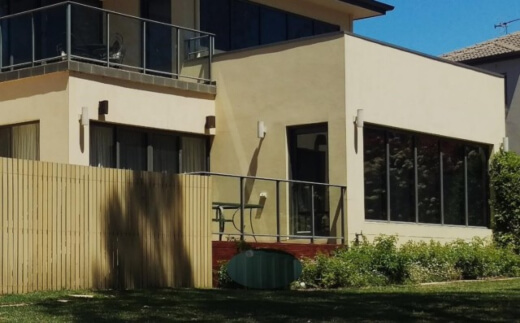
Rectangular rainwater tanks are another form of water storage that goes under a house or deck, but uses a more traditional water tank design. Although they are more challenging to install and less versatile than a bladder, they are also significantly cheaper.
Rectangle water tanks are designed with durable wall linings reinforced by long, flat panels to protect against rodent and pest damage.
In-Ground and Underground Water Tanks

Underground water tanks are built into the ground and are a great choice if you're short on surface space. The best time to install an underground water tank is during the early stages of property development before the foundation has been laid for construction.
If you already have a well established house and yard, then another option might be more suitable.
Retaining Wall Water Tanks

Designed to double as an actual retaining wall, this is a newer style of tank and a great way to conceal its presence within a yard. Sturdy and versatile, they can be clad with stone, stacked together, or feature a planter box on top for growing plants and herbs.
What Size Tank Do You Need?
YourHome, the Australian Government's sustainable homes guide, suggests the following rainwater tank sizes depending on the primary function of the tank.
- Gardening: 200 - 2,000 Litre capacity
- Flushing toilets and gardening: 2,000 - 3,600 Litre capacity
- Flushing toilets, washing clothes and gardening: 3,600 – 6,000 Litre capacity
- Catering for a home's complete water supply: 6,000 to 20,000 Litre capacity
Before shopping, you can estimate what size rainwater tank will suit your needs with a rainwater catchment calculator.
Complete Water Tank Prices

It's difficult to put a dollar value on the cost of a complete water tank setup without receiving a personalised quote. The total price will depend on several factors, including:
- Tank material
- Tank size
- Purpose and features
- Set up and installation
- Delivery costs
- Available incentives or rebates
To store drinking water, your tank will also need to possess a food grade lining, be treated with additional chemicals and require regular property maintenance like cleaning gutters and changing water filters.
Rainwater tank rebates are available across the country to help you save on the costs of a purchase. The rebates differ from council to council, but they are certainly worth investigating before making a significant purchase. Contact your local council for further information.
Laws Surrounding Rainwater Storage Tanks
Most households in Australia get tap water from public water systems, commonly referred to as "mains water" connections. Mains water is sourced from reservoirs, lakes, aquifers, rivers, and other large bodies of fresh water located near cities and towns.
Due to the danger posed by fires, homes in bushfire zones or "bushfire protection areas" are generally required by law to have at least one accessible rainwater tank to help with firefighting efforts.
If you live in an area prone to bushfires or otherwise at risk of fires, consult with your local council or home builder to find out whether this applies to you.
Although less common, some councils in Australia have minimum requirements for the size or type of rainwater tank. For example, your local council may require your rainwater tank to store a minimum of 1,000 litres of water.
Water Saving Tips
In addition to rainwater storage tanks, there are other ways that you can maximise the efficiency of water around your home. Some additional steps to take include:
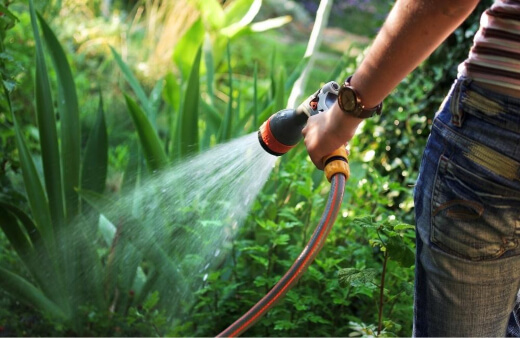
- Improving soil quality for better capacity and duration of water retention
- Mulching soil after planting can help to reduce run off
- Planting trees, plants, or creating artificial shade to keep soil temperature low
- Planting or creating windbreaks
- Using drip irrigation to water plants at a consistent pace
(See our guide on the Best Irrigation and Water Systems for Australian Gardens) - Water in the early morning or in the evening when cooler temperatures help water penetration and retention
Additional ways that you can reduce water consumption outside include:
- Ensuring pools and water features are covered by shade to prevent evaporation
- Sweeping driveways rather than washing them clean
- Keeping plants grouped together
- Opting for hardy or succulent plants, trees, and shrubs that require little water, including native Australian plants
- Reducing lawn area, or choosing a lawn type that uses less water (or even choosing artificial lawn)
- Recycling and using alternative water sources such as recycling greywater
- Monitoring and fixing leaks as soon as possible
Should You Buy a Rainwater Tank?
Absolutely! The benefits of rainwater harvesting quickly outweigh the cost and installation of a new tank. Even without being legally obliged to install a rainwater tank, it's always wise to have water on hand.
Australia is a hot, dry country prone to drought and fires. Having a large supply of H²O can help protect and maintain a home through natural disasters, and you can save money on utilities at the same time.
Published on February 16, 2022 by Gary Clarke
Last Updated on October 17, 2024




